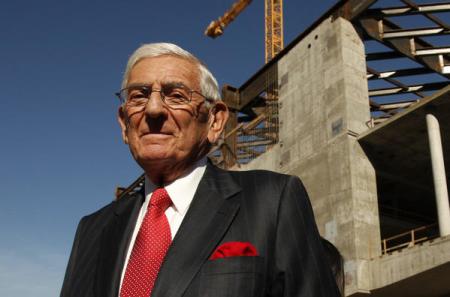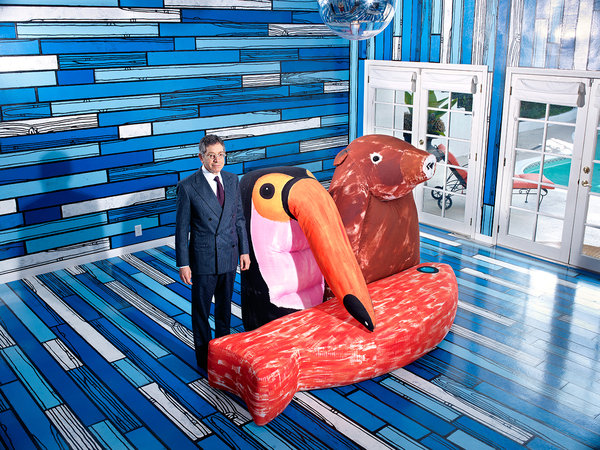Archive for the ‘Los Angeles’ Category
Chapter 3 (Part1): Collector-Created Cultural Capitals
“Los Angeles in my view is becoming the contemporary art capital of the world.”[i] – Eli Broad
LA, or certain people who write about the art scene in LA, or people who get quoted about the art scene in LA, seems to have an inferiority complex. Everything that happens in the arts (a new exhibition, a new art fair, a new museum director…) is deemed the thing that will finally turn LA into an/the art capitol. William Poundstone did a survey of this decades-long mentality[ii] this week inspired by an article in The Economist titled, “2014 may prove a turning point for art museums in Los Angeles.”[iii] But come on – LA, people who write about the art scene in LA, people who get quoted about the art scene in LA, and the people of LA have nothing to prove. The Getty squashed that issue a few years ago, didn’t it?
Back in 2011, the Getty’s ten-years-in-the-making endeavor, Pacific Standard Time (or PST as it has come to be known) opened. Over 60 institutions across Southern California presented exhibitions focused on the region’s art scene between the years of 1945 and 1980. The Getty’s goal was to record, preserve, and present the many contributions Southern Californian artists and arts organizations made to contemporary art during the time period. Initial grants were given to arts organizations to catalogue archives from the period, followed by exhibition grants. Some of these exhibitions traveled to other venues in the country and some traveled internationally. Catalogues from these exhibitions were published and quickly integrated into university curriculums. Besides this trove of scholarship, another goal of PST was to present Los Angeles as an artistic capital.
The Art & Technology and Program
LACMA
When I read the news this week that LACMA is bringing back its legendary Art and Technology Program, I basically freaked out. But before I get into the new program I wanted to re-explore the original program. (I knew this grad school paper would come in useful for something.) I gleefully just re-read the program’s catalogue: A Report on the Art and Technology program of the Los Angeles County Museum of Art. Long title, amaaaaazing read.
ART AND TECHNOLOGY PROGRAM, 1967 – 1971
In 1967, the five-year-old Los Angeles County Museum of Art began a multi-year project called The Art & Technology Program. The Program placed artists into residencies within technology companies with the intention that these corporations facilitate and/or fabricate the creation of new works, which would be shown in a culminating exhibition at the museum. The Art and Technology Program was the brainchild of LACMA’s curator of Modern Art, Maurice Tuchman. Read the rest of this entry »
MOCA Leadership & Their Museums
Jeffrey Deitch will bid adieu to the Museum of Contemporary Art and the Best Coast and head back to New York, where his genius is appreciated and where he is already curating a show. Poor Deitch, un-hip, philistine LA just didn’t get him. The biggest Deitch defender in the press has been Art in the Streets associate curator (non-MOCA curator) Aaron Rose: “We had something going in L.A., and it’s over now. Jeffrey’s resigning is really a statement about what the city is. All people in L.A. want is interior design. They want paintings to put over the couch.” Let’s leave generalizations about “people in L.A.” out of this Aaron Rose, and take a moment to remember that time New York Times Magazine did a spread on “Jeffrey’s Deitch’s Party House.” Let’s talk about that interior design Aaron Rose: Deitch may not have paintings over his couch, but he does have painted couches.
Chapter 2 (Part 3): Venture Philanthropy & Other Styles of Giving
“Andrew Carnegie said, ‘He who dies with wealth dies in shame.’ And someone once said, ‘He who gives while he lives also knows where it goes.’”[i] – Eli Broad
Eli Broad’s power is tolerated because it remains remarkably unchallenged. This seemingly monopoly of philanthropic power led Christopher Knight to compare Broad to another infamous, Los Angeles art patron:
[Norton] Simon’s flirtations with giving [his] collection away (to at least seven institutions); distrust of traditional museum management; engineering of a bailout of an artistically adventuresome but financially faltering institution (the old Pasadena Museum for Simon, MOCA for Broad); later deciding to open his own museum, and more…[ii]
Another similarity to Broad: Before Norton Simon’s takeover of the Pasadena Art Museum, Simon had intended to establish his collection as a lending organization. Taking control of the Pasadena Art Museum proved irresistible to Simon, and today the Norton Simon Museum rarely loans works. I seriously doubt unfounded rumors that Broad has some kind of evil master plan to takeover or somehow combine his collections with MOCA.
Broad can also be measured to his contemporaries. Los Angeles is not actually a one-philanthropist town. “Pomegranate Queen” Lynda Resnick is an easy comparison. Like Broad, Resnick is a long-time donor and trustee of LACMA. Like Broad, she and her husband provided funds ($54 million) for a Renzo-Piano-designed building at LACMA. The Lynda and Stuart Resnick Pavilion was part of Phase 2 of LACMA’s Transformation and sits directly north of BCAM. When the pavilion opened in October of 2010, one of three inaugural shows was gleaned from the Resnick’s private collection.





